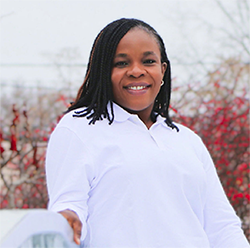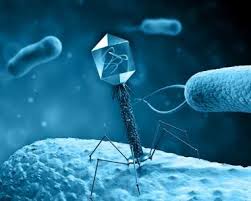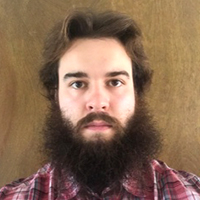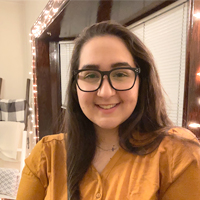Blessing Emerenini Group
My research program can be grouped into two arms: (I) Understanding dynamics in bacterial communication and Biofilm-Phage Interactions; and (II) Developing Deterministic and Stochastic frameworks for epidemiological studies.
About Blessing Emerenini
 The focus of my research is in mathematical and computational biology with particular applications in ecology, infectious diseases, and agriculture through modeling, analysis, and simulations. Depending on the particular application, these can be nonlinear ordinary differential equations, partial differential equations, stochastic models, or Agent-based models. So far, I have developed and studied models for biofilms, quorum sensing, t6ss killing, and characterizations to determine the success of bacterial genotypes in ecological processes, within-host infectious disease dynamics, biofilm-phage interactions, host heterogeneity in disease transmission and superspreading events.
The focus of my research is in mathematical and computational biology with particular applications in ecology, infectious diseases, and agriculture through modeling, analysis, and simulations. Depending on the particular application, these can be nonlinear ordinary differential equations, partial differential equations, stochastic models, or Agent-based models. So far, I have developed and studied models for biofilms, quorum sensing, t6ss killing, and characterizations to determine the success of bacterial genotypes in ecological processes, within-host infectious disease dynamics, biofilm-phage interactions, host heterogeneity in disease transmission and superspreading events.
Announcement: I am looking for undergraduate or graduate students who want to pursue research in this area, please send me email.
Research
Main Interest
I am interested in creating accurate models of the spread of infectious diseases within-host, accurately capturing how bacteria and viruses communicate and spread from cell to cell. The goals of my research program are to (i) develop a diverse and productive research program that investigate characterizations of both related and conflicting phenomena in the study of infectious diseases and microbial ecology through modeling, mathematical analysis and scientific computing, (ii) provide strong scientific results that support other experimental/laboratory investigations and basis for public health stakeholders decisions, (iii) train students in research writing, mathematical modeling, and scientific computing.
 Mechanisms and evolution of bacterial cooperation and communication in biofilms.
Mechanisms and evolution of bacterial cooperation and communication in biofilms.
Microbial cooperative behaviors are ubiquitous and important in pathogenic and non-pathogenic environments. Investigating cooperative behaviors such as Cell-cell communication, also termed quorum sensing, and siderophore-mediated iron chelation. Studying non-linear diffusion-reaction systems that arise in modeling bacterial cooperation and communications, multi-species interaction, response to antibiotics, detachment, and dispersal.
This is a classic example of competitive coevolution in nature which has the potency to define the biofilm structure, bacteria resistance, and phage mutations. Besides intrinsic value, the biofilm-phage interactions can provide beneficial inputs towards better experimental design; using differential equations (both ordinary, delay, and partial differential equations) can be used to successfully model the interaction dynamics in a well-mixed population, in cystic fibrosis. The presence of spatial restrictions in the interaction media, cell migrations, and planktonic proliferation can significantly affect the interaction dynamics. We study the modeling techniques, validating with empirical data from the collaborator’s lab.
Inhibiting disease spread among (i)plants and (ii)humans within a human-human, human-animal, and avian populations; identifying how spatial and temporal patterns, causes and processes affect variations in outbreak and epidemics.
Because humans and animals (birds inclusive) live in a heterogeneous environment that is constantly changing in response to disturbances via civilization, industrializations, successional processes, etc.; it is imperative to consider host transmissibility and heterogeneity. Knowledge of how spatial patterns and temporal dynamics of disease-spread and population dynamics is essential in order to predict and possibly control an epidemic/outbreak. The key to understanding and controlling the spread of lethal pathogens is to identify how the disease flows through the host population and more specifically which individuals are responsible for the majority of the transmission. Those hosts that attract many vectors will tend to be the focus of transmission. But to what extent, and can we identify the characteristics of these key hosts?
Localization and viral transport within human host; investigating the characterizations, kinetics, and interactions with the host immune system.
Viruses use the host synthetic machinery to replicate. When a virus makes it into any point in space within the host, e.g. the upper Respiratory Tract (RT), it is transported upwards through the mucous gel at a certain velocity. Infection is initiated at the vicinity of the top of the RT and the infected cells produce more viruses. More cells are infected as the virions diffuse in the direction of uninfected target cells down the RT. It has been reported experimentally that the spread of some species of virus depends on its interaction with infected cells through a phenomenon referred to as the repulsion effect. Mathematical models provide further insights on the spread of viruses based on density-dependent diffusion and the traveling wave solutions.
Active Collaborations

Trevor Lax |

Claire Canner |
2021 – REU – Rochester Institute of Technology
Doris Hartung – Shippensburg University
Maya Williams – The College of New Jersey
2020 REU – Oregon State University
Kevin Sweet – Lewis and Clark
Abigail Ezell – Colorado College
Darwin Nesheim – Oregon State University
2019 REU – Oregon State University
Krista Wurscher – the University of Oregon (Accepted Admission to Ohio State University for Masters in Statistics)
Cassandra Williams – Sunny New Paltz
2019 Prestigeous URSA Engage Award Undergraduate Students – Oregon State University
Abigail Bernasconi
Darwin Nesheim
Elizabeth Riutta
Linda Allen and Angela Peace – Texas Tech. University, USA
Christina Edholm – Scripps College, USA
Xueying Wang – Washington State University, USA
Anarina Murillo – New York University, USA
Nika Shakiba – British Columbia University, Canada
Uduak George and Dwayne - San Diego State University, USA
Robert Osgood – Rochester Institute of Technology, USA
Hermann Eberl – University of Guelph, Canada
Simeion C. Inyama – Federal University of Technology, Owerri, Nigeria
Selected Publications
Blessing O. Emerenini, Ricardo N. G. Reyes Grimaldo$^{**}$, Cassandra Williams$^*$, Krista Wurscher$^{*}$, Ekeoma R. Ijioma. Mathematical modeling and analysis of flu infection dynamics within host. (In Review) Letters in Biomathematics, 2021.
Blessing O. Emerenini, Hermann J. Eberl, Reactor scale modeling of quorum sensing induced biofilm dispersal (2021) AppliedMathematics and Computation (In Review)
Blessing O. Emerenini et al. Effect of colonization and cell migrationin in biofilm - phage interaction in cystic fibrosis. (2021) PlosOne (Submitted)
Shakiba, N., Edholm, C. J., Emerenini, B. O., Murillo, A. L., Peace, A., Saucedo, O., Wang, X., and Allen, L. (2021). Effects of environmental variability on superspreading transmission events in stochastic epidemic models. Infectious Disease Modelling, 6, 560–583. https://doi.org/10.1016/j.idm.2021.03.001
Joy Uwakwe$^{**}$, Simeon Inyama Blessing O. Emerenini, Mathematical model and optimal control of the transmission dynamics of avian spirochaetosis, Journal of Applied Mathematics and Physics, 2020 https://www.scirp.org/pdf/jamp_2020020714342247.pdf
Christina Edholm, Blessing O. Emerenini, Anarina Murillo, Omar Saucedo, Nika Shakiba, Xueying Wang, Linda Allen, Angela Peace, Searching for superspreaders: Identifying epidemic patterns associated with superspreading events in stochastic models In: Radunskaya A., Segal R., Shtylla B. (eds) Understanding Complex Biological Systems with Mathematics. Association for Women in Mathematics Series, vol 14. Springer, Cham. 2018 https://www.ncbi.nlm.nih.gov/pmc/articles/PMC7123311/
Blessing O. Emerenini, Stefanie Sonner, Hermann J. Eberl. Mathematical Analysis of a Quorum Sensing Induced Biofilm Dispersal Model and Numerical Simulation of Hollowing Effects, published in Mathematical Biosciences and Engineering, 2017 https://pubmed.ncbi.nlm.nih.gov/28092956/
Blessing O. Emerenini, Burkhard A. Hense, Christina Kuttler, Hermann J. Eberl. Mathematical Model of Quorum Sensing Induced Biofilm Cell Detachment, published in PLOSONE, 2015, https://doi.org/10.1371/journal.pone.0132385
KEY: * and ** indicate students co-authors




